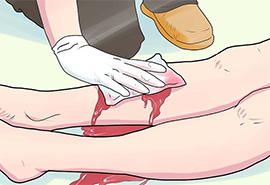
Types of Bleeding
Before trying to stop severe bleeding, if possible, clean hands to avoid infection and put on synthetic gloves. Don't move displaced organs instead dress the wound.
For other cases of severe bleeding, follow these steps:
Your principal concern is to stop the bleeding.
- Wash hands. If possible, put on clean synthetic gloves.
- Make the injured person lie down. Slightly elevate the legs or try to position the person's head slightly lower than the trunk. If possible, keep the affected area elevated.
- Carefully, remove any obvious foreign objects from the wound, this includes dirt. If there are any large or deeply embedded objects don't remove them, or probe the wound and attempt to clean it.
- Apply pressure directly to the wound. If available use a sterile bandage, clean cloth or even a piece of clothing, if there's nothing else use your hand.
- Maintain pressure until the bleeding stops (by the palm of the hand or by binding the wound tightly with a bandage and adhesive tape). Hold continuous pressure for at least 20 minutes; don't discontinue pressure to see if the bleeding stopped.
- Don't remove the bandage. If the bleeding continues through the material you are holding on the wound, don't remove it. Instead, add more absorbent material on top of it.
- Apply direct pressure to a main artery delivering blood to the area of the wound if the bleeding doesn't stop. (Pressure points of the arm are on the inside of the arm just above the elbow and just below the armpit. Pressure points of the leg are just behind the knee and in the groin.) Press hard on the main artery in these areas against the bone. Keep your fingers flat. With your other hand, continue to exert pressure on the wound itself.
- Once the bleeding has stopped, don't move the injured body part. Leave the bandages on the wound and get the injured person to the emergency room as soon as possible.
- When internal bleeding is suspected, call for emergency medical assistance.
The following signs might indicate internal bleeding:
- Bleeding from body cavities (e.g. ear).
- Coughing up blood.
- Bruising on neck, chest, abdomen or side.
- Wounds that have penetrated the skull, chest or abdomen.
- Abdominal tenderness, possibly accompanied by rigidity or spasm of abdominal muscles.
- Fractures.
- Shock (weakness, anxiety, thirst or clammy skin).


